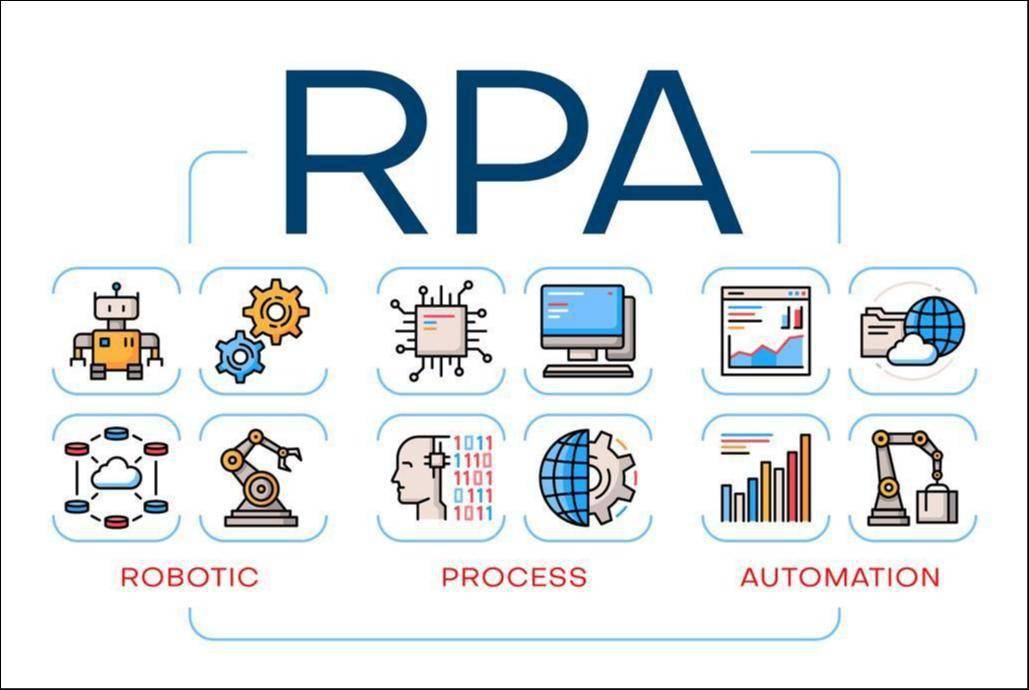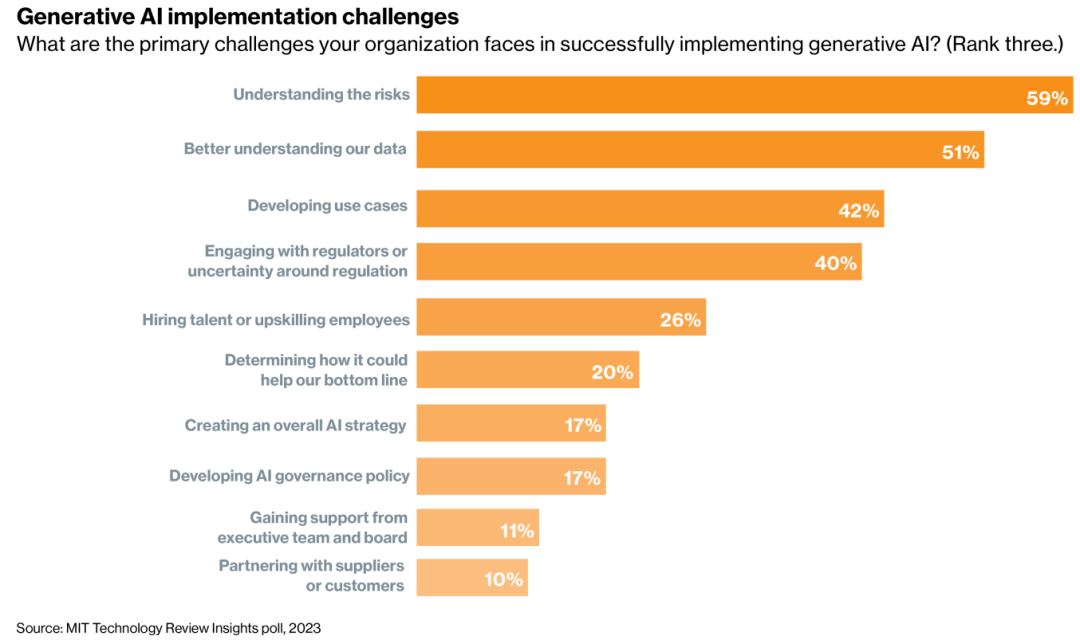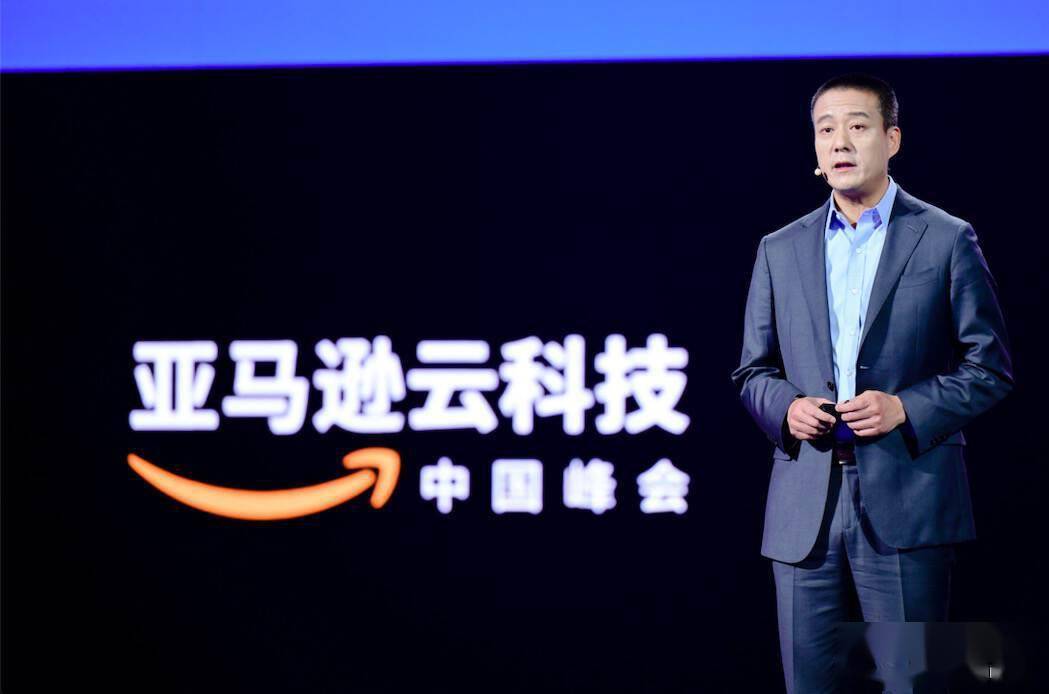 Technology peripherals
Technology peripherals AI
AI Small companies are three times more likely to deploy large generative AI models than mid-sized companies, survey reveals
Small companies are three times more likely to deploy large generative AI models than mid-sized companies, survey revealsAfter over-hyping a range of technologies including Web3, virtual worlds and blockchain, business executives are bracing for a wave of generative artificial intelligence. Some believe that artificial intelligence will bring about changes comparable to the birth of the Internet or the emergence of desktop computers
But with greater ability comes greater responsibility. Generative AI brings as much risk as reward. This technology is challenging legal regimes around copyright and intellectual property, creating new cyber and data governance threats, and causing “automation anxiety” in labor-intensive activities.
To meet stakeholder expectations, companies need to act quickly but must do so carefully to ensure they do not violate regulations or ethical standards in areas such as data privacy and bias
On the operational side, enterprises need to reconfigure human resources and establish partnerships with technology companies to design safe, effective, and reliable generative artificial intelligence
To gauge the current thinking of key business decision-makers, MIT Technology Review’s Insights panel surveyed 1,000 business executives, asking them about current and anticipated AI use cases, implementation barriers, and technology strategies. and perspectives on workforce planning
Based on the opinions of an expert interview panel, this survey reflects the current mainstream strategic thinking factors and perspectives of enterprises in the face of generative artificial intelligence, and can help executives reason and explain the process of making major decisions
The following are the main results of the survey and interviews:
Executives are well aware of the transformative potential of generative AI, but they are wary of deploying it. Nearly all companies believe generative AI will impact their business, with only 4% believing it will not impact them. But at this point, only 9% have fully deployed generative AI use cases in their organizations.
This figure is as low as 2% in the government sector, while financial services (17%) and IT (28%) are the two industries with the highest proportion of use case deployments. The biggest barrier to deploying AI is understanding the risks of generative AI, with 59% of respondents citing it as one of the top three challenges.
 (Source: see watermark)
(Source: see watermark)
At the same time, companies will not fight alone. Collaboration with startups and large tech companies is critical to the smooth expansion of AI technology. The majority of executives (75%) plan to work with partners to introduce generative AI at scale to their organizations, with fewer (10%) citing collaboration as the top technology implementation challenge. This demonstrates that we have a strong ecosystem of technology providers and services available for collaboration and co-creation.
Big tech companies have ecosystem advantages as developers of generative AI models and providers of AI software, but startups have advantages in several specialized niche areas. Executives are more likely to plan to partner with smaller companies (43%) that focus on a certain direction of AI technology than with large tech companies (32%).
The application of generative AI will democratize the entire economy. According to our survey, company size has no bearing on the likelihood that a company will experiment with generative AI. Small companies (less than $500 million in annual revenue) deploy generative AI at three times the rate of mid-sized companies ($500 million to $1 billion) (13% vs. 4%)
In fact, these smaller companies are deploying and experimenting with AI technology at rates similar to those of the largest companies (those with more than $10 billion in revenue).
Affordable generative AI tools that can boost small businesses just like cloud computing, which gives businesses access to more tools and computing resources that once required hardware and technology make huge investments.
A quarter of respondents expect the main impact of generative AI to be a reduction in their workforce. The share is even higher in industrial sectors such as energy and utilities (43%), manufacturing (34%), and transportation and logistics (31%). This figure is lowest in the IT and telecommunications industry (7%)
In general, compared with humans being replaced by artificial intelligence, this data (proportion) is acceptable. Demand for related skills is increasing in technical areas focused on operating artificial intelligence models, as well as in management positions that deal with ethics and risk.
Artificial intelligence is democratizing technical skills, potentially leading to new job opportunities and increased employee satisfaction. But experts warn that if not deployed correctly and without meaningful consultation, generative AI could reduce the quality of human work experience
Regulatory issues are urgent, but uncertainty is currently the biggest challenge. Generative AI has sparked a flurry of policy-making activity as lawmakers in countries like the United States try to avoid risks, but truly impactful regulation will advance at the pace of government legislation (slowly)
Meanwhile, many business leaders (40%) believe that dealing with regulatory or regulatory uncertainty is a major challenge in adopting generative AI. This proportion varies by industry, ranging from 54% in the government sector to 20% in the IT and telecoms industry.
The above is the detailed content of Small companies are three times more likely to deploy large generative AI models than mid-sized companies, survey reveals. For more information, please follow other related articles on the PHP Chinese website!
 华裔数学家陶哲轩领导白宫生成式AI工作组,李飞飞将在小组演讲May 25, 2023 am 10:36 AM
华裔数学家陶哲轩领导白宫生成式AI工作组,李飞飞将在小组演讲May 25, 2023 am 10:36 AM·美国总统科技顾问委员会成立的生成式AI工作组旨在帮助评估人工智能领域的关键机遇和风险,并就尽可能确保公平、安全、负责地开发和部署这些技术向美国总统提供意见。·AMD的首席执行官苏姿丰(LisaSu)和谷歌云首席信息安全官菲尔·维纳布尔斯(PhilVenables)也是这个工作组的成员。华裔数学家、菲尔茨奖获得者陶哲轩。当地时间5月13日,华裔数学家、菲尔茨奖获得者陶哲轩公布消息,他和物理学家劳拉·格林(LauraGreene)共同领导美国总统科技顾问委员会(PCAST)的生成式人工智能工作组。
 从“人+RPA”到“人+生成式AI+RPA”,LLM如何影响RPA人机交互?Jun 05, 2023 pm 12:30 PM
从“人+RPA”到“人+生成式AI+RPA”,LLM如何影响RPA人机交互?Jun 05, 2023 pm 12:30 PM图片来源@视觉中国文|王吉伟从“人+RPA”到“人+生成式AI+RPA”,LLM如何影响RPA人机交互?换个角度,从人机交互看LLM如何影响RPA?影响程序开发与流程自动化人机交互的RPA,现在也要被LLM改变了?LLM如何影响人机交互?生成式AI怎么改变RPA人机交互?一文看明白:大模型时代来临,基于LLM的生成式AI正在快速变革RPA人机交互;生成式AI重新定义人机交互,LLM正在影响RPA软件架构变迁。如果问RPA对程序开发以及自动化有哪些贡献,其中一个答案便是它改变了人机交互(HCI,h
 告别设计软件一句话生成效果图,生成式AI颠覆装饰装修领域,附28款流行工具Jun 10, 2023 pm 03:33 PM
告别设计软件一句话生成效果图,生成式AI颠覆装饰装修领域,附28款流行工具Jun 10, 2023 pm 03:33 PM▲本图由AI生成酷家乐、三维家、东易日盛等已出手,装饰装修产业链大举引入AIGC生成式AI在装饰装修领域有哪些应用?对设计师有啥影响?一文看懂告别各种设计软件一句话生成效果图,生成式AI正颠覆装饰装修领域使用人工智能增强能力提升设计效率,生成式AI变革装饰装修行业生成式AI对装饰装修行业有哪些影响?未来发展趋势如何?一文看懂LLM变革装饰装修,这28款流行生成式AI装修设计工具值得上手体验文/王吉伟在装饰装修领域,最近与AIGC关联的消息着实不少。Collov推出了生成式AI驱动的设计工具Col
 观察:将生成式AI应用于网络自动化有何潜力?Aug 17, 2023 pm 07:57 PM
观察:将生成式AI应用于网络自动化有何潜力?Aug 17, 2023 pm 07:57 PM根据市场研究公司Omdia的一份最新报告,预计到2023年,生成式人工智能(GenAI)将成为一个引人注目的技术趋势,为企业和个人带来重要的应用,包括教育。在电信领域,GenAI的用例主要集中在提供个性化营销内容或支持更复杂的虚拟助手,以提升客户体验尽管生成式AI在网络运营中的应用并不明显,但EnterpriseWeb进行了一项有趣的概念验证,展示了该领域中生成式AI的潜力生成式AI在网络自动化方面的能力和限制生成式AI在网络运营中的早期应用之一是利用交互式指导替代工程手册来帮助安装网络元件,从
 微软和西门子联手将生成式AI引入制造业,可让仿真时间从数周缩短到几分钟Nov 01, 2023 pm 08:17 PM
微软和西门子联手将生成式AI引入制造业,可让仿真时间从数周缩短到几分钟Nov 01, 2023 pm 08:17 PM11月1日消息,微软和西门子宣布加深在生成式人工智能(AI)领域的合作,并将其应用于全球各行各业。为了实现人机协作的革命性突破,两家公司推出了西门子工业Copilot,这是一款联合开发的人工智能助手,旨在提高制造业的生产力。通过利用微软的AzureOpenAI服务,结合西门子工业的专业技术和Xcelerator平台的数据,西门子工业Copilot可以轻松生成、优化和调试复杂的自动化代码,实现自然语言交互。两家公司表示,这项技术可以将一些耗时数周的任务缩短到几分钟,例如仿真过程IT之家注意到,Co
 小公司部署生成式AI大模型的比例是中型公司的3倍,调查揭示Oct 15, 2023 pm 05:21 PM
小公司部署生成式AI大模型的比例是中型公司的3倍,调查揭示Oct 15, 2023 pm 05:21 PM在过度炒作了Web3、虚拟世界和区块链等一系列技术之后,企业高管们正在准备迎接生成式人工智能的浪潮。有人认为,人工智能带来的变革将与互联网的诞生或台式电脑的出现相媲美但能力越大,责任越大。生成式人工智能带来的风险与回报一样多。这项技术正在挑战版权和知识产权方面的法律制度,创造新的网络和数据治理威胁,并在劳动密集的活动中引发了“自动化焦虑”。为了满足利益相关者的期望,公司需要迅速采取行动,但必须谨慎行事,以确保在数据隐私和偏见等领域不违反法规或道德标准在运营方面,企业需要重新配置人力资源,并与科技
 红帽全球峰会:生成式AI令人期待,开源领域迎来好时机Jun 06, 2023 am 08:06 AM
红帽全球峰会:生成式AI令人期待,开源领域迎来好时机Jun 06, 2023 am 08:06 AM作为全球开源领域一年一度的行业盛宴,2023红帽全球峰会于近日如约而至。红帽带来全球开源盛宴在本届峰会上,红帽发布了最新版的OpenShiftAI、搭载IBMWatsonCodeAssistant的AnsibleLightspeed等一系列新品,并且针对媒体记者最为关心的热点话题分享了红帽的观点与看法。红帽总裁兼CEOMattHicks表示:“我们对未来充满了激动和期待,特别是在人工智能和新技术方面。我们发布了一些令人兴奋的新产品,其中包括OpenShiftAI。然而要实现这一愿景,我们还需要注
 生成式AI爆发,亚马逊云科技持续专注创新,助力企业数字化转型Jul 13, 2023 pm 08:54 PM
生成式AI爆发,亚马逊云科技持续专注创新,助力企业数字化转型Jul 13, 2023 pm 08:54 PM2023年的科技圈什么技术最火,毫无疑问,回答都会指向生成式AI。生成式AI的到来引发了业内外广泛讨论,也引发了大家对AI发展的新一轮思考——未来几年,生成式AI会成为最重要的生产力工具,无论是训练还是推理端,算力需求都将有望爆发式增长。在6月28日举行的2023年亚马逊云科技中国峰会上,亚马逊云科技大中华区产品部总经理陈晓建发表了名为《专注创新,摆脱基础架构束缚》的主题演讲,他认为,“当前,虽然生成式AI只有短短几个月,但其超大规模人工智能模型和海量数据对高算力提出新要求,不断拉动算力需求快速


Hot AI Tools

Undresser.AI Undress
AI-powered app for creating realistic nude photos

AI Clothes Remover
Online AI tool for removing clothes from photos.

Undress AI Tool
Undress images for free

Clothoff.io
AI clothes remover

AI Hentai Generator
Generate AI Hentai for free.

Hot Article

Hot Tools

Safe Exam Browser
Safe Exam Browser is a secure browser environment for taking online exams securely. This software turns any computer into a secure workstation. It controls access to any utility and prevents students from using unauthorized resources.

PhpStorm Mac version
The latest (2018.2.1) professional PHP integrated development tool

SublimeText3 Chinese version
Chinese version, very easy to use

MinGW - Minimalist GNU for Windows
This project is in the process of being migrated to osdn.net/projects/mingw, you can continue to follow us there. MinGW: A native Windows port of the GNU Compiler Collection (GCC), freely distributable import libraries and header files for building native Windows applications; includes extensions to the MSVC runtime to support C99 functionality. All MinGW software can run on 64-bit Windows platforms.

Dreamweaver CS6
Visual web development tools





